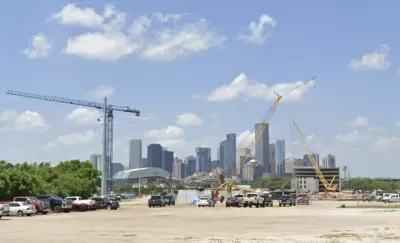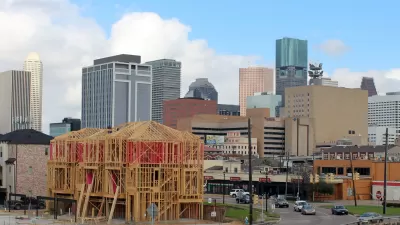Two approaches to redevelopment reveal the nuances of gentrification and neighborhood change.

In an essay adapted from his book Place and Prosperity: How Cities Help Us To Connect And Innovate and published on Next City, William Fulton describes two approaches to development in the East End, a quickly gentrifying neighborhood in Houston, Texas.
Fulton describes the area’s history as “a traditionally Hispanic neighborhood that used to be a bustling center of blue-collar business and manufacturing” and its recent and rapid transformation. Today, the neighborhood is served by a light rail line that provides a fast link to downtown Houston, and developers are building new housing.
The two projects highlighted by Fulton in this piece show two approaches to redeveloping properties in the East End. One is a sprawling mixed-use development located on the site of a former engineering complex, “perhaps the largest vacant site in any urban location in the United States.” The developer plans to mitigate the negative impacts of the project through actions outlined in a Community Benefits Agreement (CBA), a legal commitment to provide assistance to specific community causes.
The second project, run by the Concept Neighborhood group, focuses on retrofitting old buildings to house small, local businesses. Commercial tenants are charged rent on a sliding scale based on their sales. Despite these efforts to keep prosperity in the neighborhood, Fulton points out that the developers acknowledge “The value of their property will go up no matter what, to the detriment of some local residents.”
For Fulton, this illustrates the core conundrum of what we call gentrification. “Places are improved by prosperity — indeed, places cannot thrive without prosperity. But in a society with deepening inequality, places (and people) can also be overrun by prosperity.” In Fulton’s view, “The question is not how to deflect investment – but, rather, how to ensure it benefits people who live in the neighborhood already as well as newcomers.”
FULL STORY: Two Houston Developments Show Two Approaches To Gentrification

Alabama: Trump Terminates Settlements for Black Communities Harmed By Raw Sewage
Trump deemed the landmark civil rights agreement “illegal DEI and environmental justice policy.”

Planetizen Federal Action Tracker
A weekly monitor of how Trump’s orders and actions are impacting planners and planning in America.

The 120 Year Old Tiny Home Villages That Sheltered San Francisco’s Earthquake Refugees
More than a century ago, San Francisco mobilized to house thousands of residents displaced by the 1906 earthquake. Could their strategy offer a model for the present?

Ken Jennings Launches Transit Web Series
The Jeopardy champ wants you to ride public transit.

BLM To Rescind Public Lands Rule
The change will downgrade conservation, once again putting federal land at risk for mining and other extractive uses.

Indy Neighborhood Group Builds Temporary Multi-Use Path
Community members, aided in part by funding from the city, repurposed a vehicle lane to create a protected bike and pedestrian path for the summer season.
Urban Design for Planners 1: Software Tools
This six-course series explores essential urban design concepts using open source software and equips planners with the tools they need to participate fully in the urban design process.
Planning for Universal Design
Learn the tools for implementing Universal Design in planning regulations.
Clanton & Associates, Inc.
Jessamine County Fiscal Court
Institute for Housing and Urban Development Studies (IHS)
City of Grandview
Harvard GSD Executive Education
Toledo-Lucas County Plan Commissions
Salt Lake City
NYU Wagner Graduate School of Public Service





























